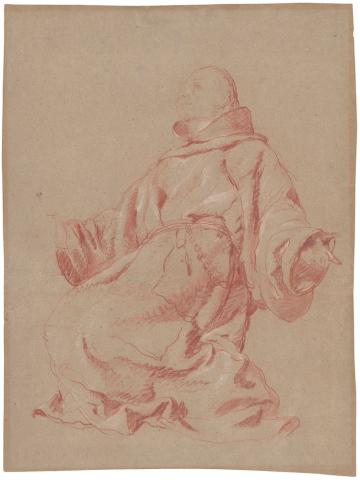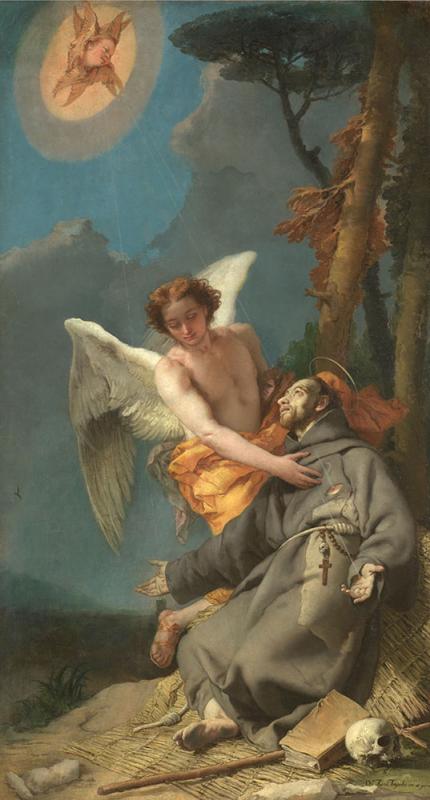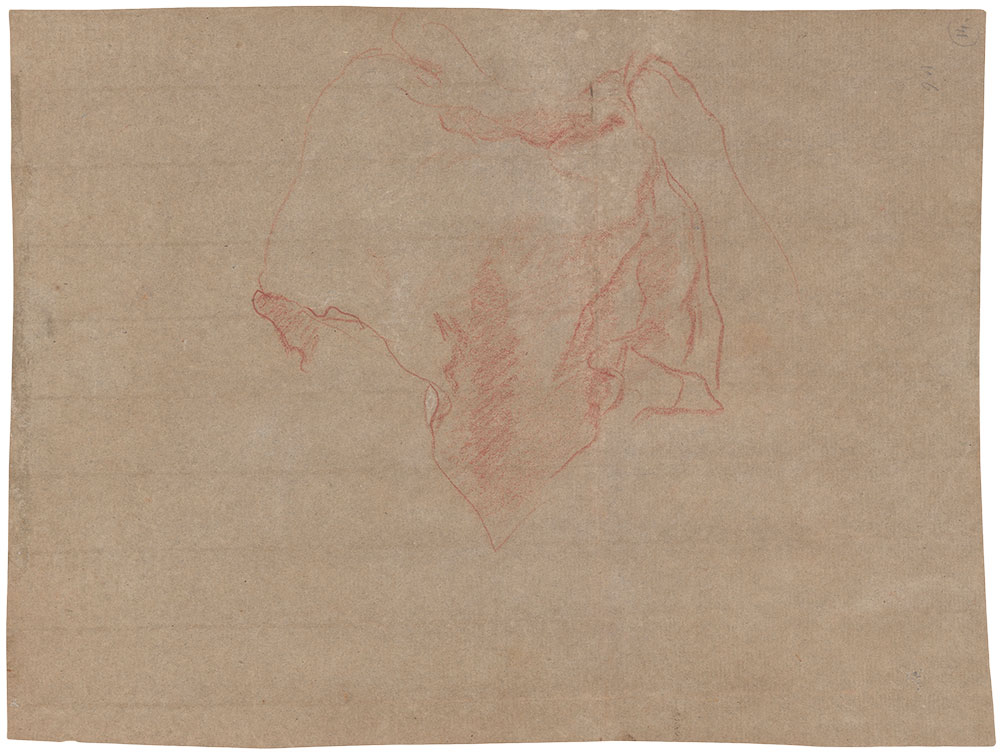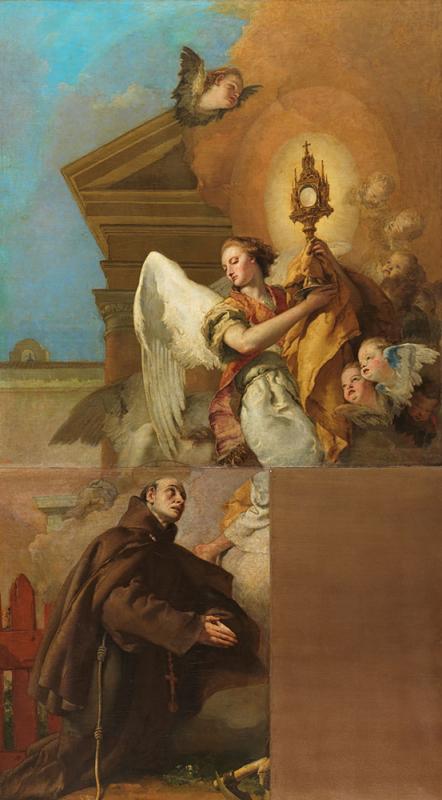
Giambattista Tiepolo, Study for Saint Francis, ca. 1767. Red and white chalk on light brown paper, 14 1/4 x 10 5/8 in. (362 x 270 mm). Purchased with the Fairfax Murray Society Fund, 2021.34.
The Morgan’s collection of drawings by the members of the Tiepolo family is one of our great strengths, for we hold roughly 200 drawings by Giambattista Tiepolo (1696–1770), 100 by his son Giandomenico (1727–1804), and a few by his younger son Lorenzo (1736–1776). These include drawings of virtually every type made by the family and drawings for most of their principal projects—with great groups of drawings for some works, such as the many studies for the Palazzo Clerici in Milan.
Because our holdings in this area are so deep, Tiepolo drawings have not been a particular priority for our acquisitions in recent years. While there seems to be an almost limitless supply of Tiepolo drawings on the art market, it would be difficult to justify spending limited acquisition funds on a drawing that is closely akin to one—or many—already in the collection.
The last major survey of our holdings in this area was the Morgan’s 2013–14 exhibition Tiepolo, Guardi, and Their World, and during the preparation of that project, a few gaps in our generally comprehensive Tiepolo holdings were noted. Specifically, and surprisingly, there was not a major red chalk figure drawing by Giambattista in the collection. Moreover, while drawings from Giambattista’s final decade, spent in Madrid, are generally rare, the Morgan nonetheless held only one example that could be connected with a Spanish project, a pen-and-wash study for a stucco overdoor in the throne room of the Royal Palace in Madrid.
We were thus excited to see the Study for Saint Francis appear in the auction previews for January. Over fourteen inches tall, this was precisely the sort of impressive red-chalk figure study that the Morgan had lacked. What was more, it was a preparatory study for a painting from Tiepolo’s time in Madrid, specifically for his St. Francis Receiving the Stigmata (Figure 1), an altarpiece painted for the Franciscan monastery of S. Pascual Bailón, but today in the Museo del Prado. The monastery had been built ca. 1756–57 under the patronage of King Charles III of Spain in the royal town of Aranjuez, south of Madrid. An oil sketch for the painting also survives and is now in the Courtauld Institute Gallery in London (Figure 2).
The altarpiece—along with several other paintings for the church—was commissioned in March 1767, and the oil sketches for them were shown to the king in late August of that year; only afterwards did Tiepolo begin work on the altarpieces themselves, which would continue until 1769. The drawing for St. Francis, a careful study of the saint’s robe, must have been made while Tiepolo planned the composition in 1767. The saint’s foot appears in both painted versions but is not shown in the drawing, and conversely, the pooling triangle of robe at lower right in the drawing is hidden by a book in both painted versions, but there are no other major changes. Given the apparently weightless pose of the drawn figure, and the summary sketch of the saint’s face and hands, one wonders whether the drapery had been placed on a mannequin for study. Nonetheless, the attitude of the saint and the calm expression on his face encapsulate the spirit of humility and simplicity that characterizes the Aranjuez paintings.
There is a second study on the verso of the drawing, which has not hitherto been fully understood. For one thing, the study does not make sense until the sheet is turned ninety degrees:
Even then, the form is still far from clear and the function of the study is not immediately apparent. It does not correspond to anything in the St. Francis altarpiece, or even to other finished projects of the time. When one looks at another of the oil sketches for the Arajuez paintings, however (Figure 3), the purpose of the drawing becomes clear: it is a study for the drapery covering the upper torso and arms of the angel in the oil sketch of The Vision of St. Paschal Baylon. In the final painting, however, which survives in fragmentary form in the Museo del Prado (Figure 4), that drapery has been eliminated. Presumably, the change to the angel’s drapery was made sometime after the oil sketches were submitted for approval in August 1767; our preparatory studies, therefore, must have been made earlier in the preparation of the work. An additional drawing of the angel, presumably made later in the process—reflecting the changes between the oil sketch and the final painting—is also in the Courtauld (Figure 5).
The oil sketches for the Aranjuez paintings have been described as “among the most moving and beautiful of Tiepolo’s paintings,” but the fate of the altarpieces was a strange one. Tiepolo died in March 1770, before the paintings could be installed in the church, and by November, a decision was made to order new altarpieces from Anton Raphael Mengs and his pupils Francisco Bayeu and Mariano Salvador Maella. Tiepolo’s paintings were sent to a convent nearby; with the suppression of many religious houses in the nineteenth century, some of them were moved to the Prado.
Finally, the new drawing has an interesting provenance that bears mentioning. It joins around twenty other Tiepolo drawings in the Morgan that were once part of the collection of the Swiss diplomat Armand-Louis François de Mestral de Saint-Saphorin (1738–1805), who worked for the King of Denmark in Warsaw, Saint Petersburg, Madrid, The Hague, and Vienna. He owned nearly one hundred Tiepolo drawings, which he probably purchased directly from the artist’s heirs in either Madrid or Venice. After his death, the drawings passed to his descendants in Switzerland, where they remained until they were sold off in groups during the twentieth century, mainly through Swiss dealers. The St. Francis was acquired by the Swiss dealer Nathan Chaikin and was later in a Parisian collection before it reappeared at auction this winter. The other Tiepolo drawings from the de Mestral collection now at the Morgan came as gifts from Janos Scholz (1903–1993), who bought those sheets in Switzerland. Scholz who was also partly responsible for research on de Mestral; the Morgan’s curatorial files include the transcript of a talk dedicated to de Mestral that Scholz delivered at the Frick Collection in 1973.
John Marciari
Charles W. Engelhard Curator
Head of the Department of Drawings and Prints
The Morgan Library & Museum






